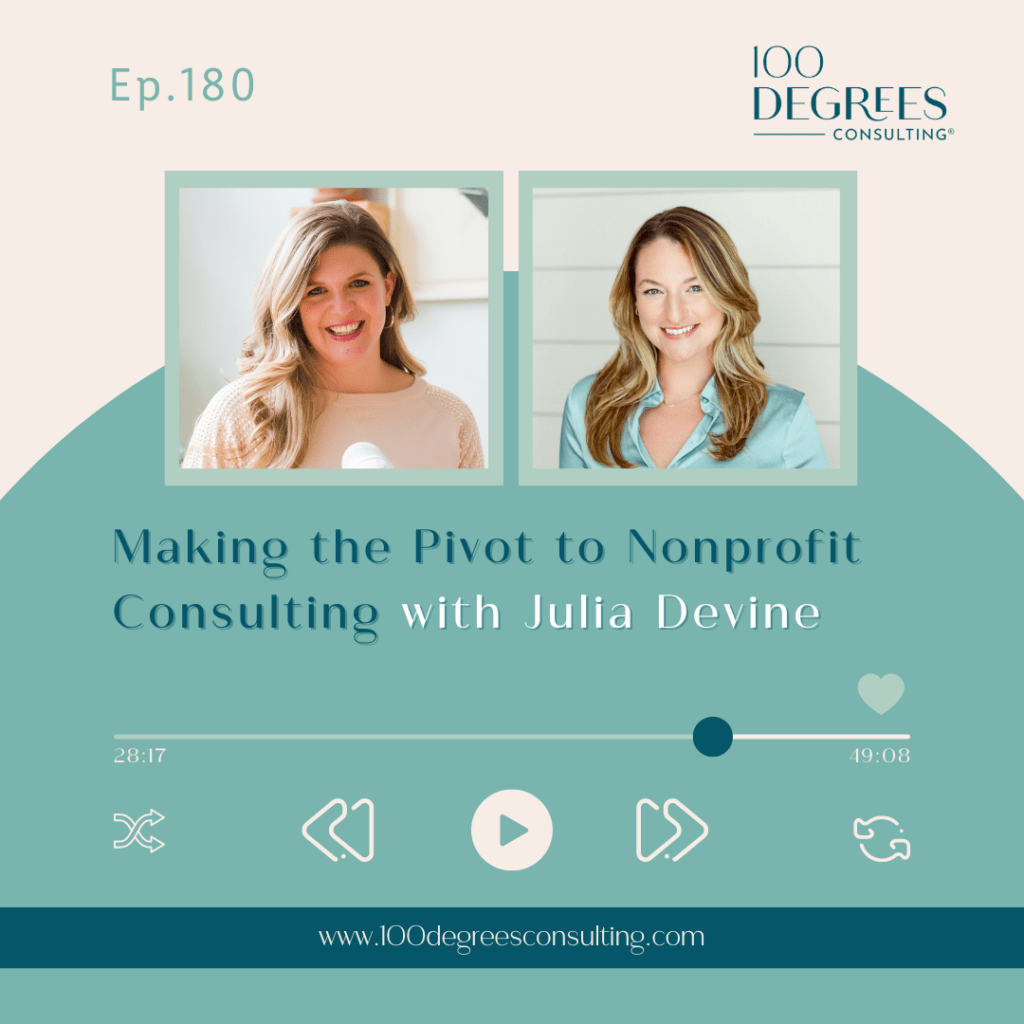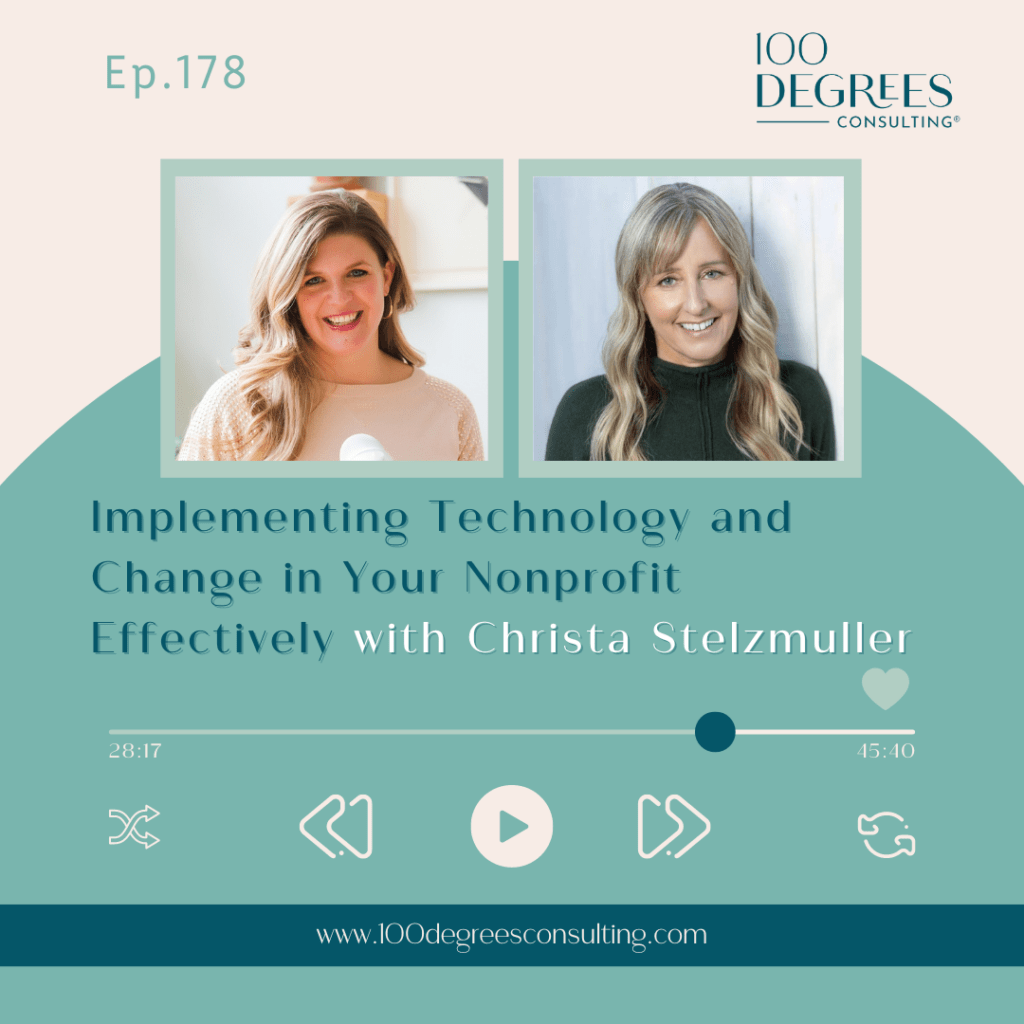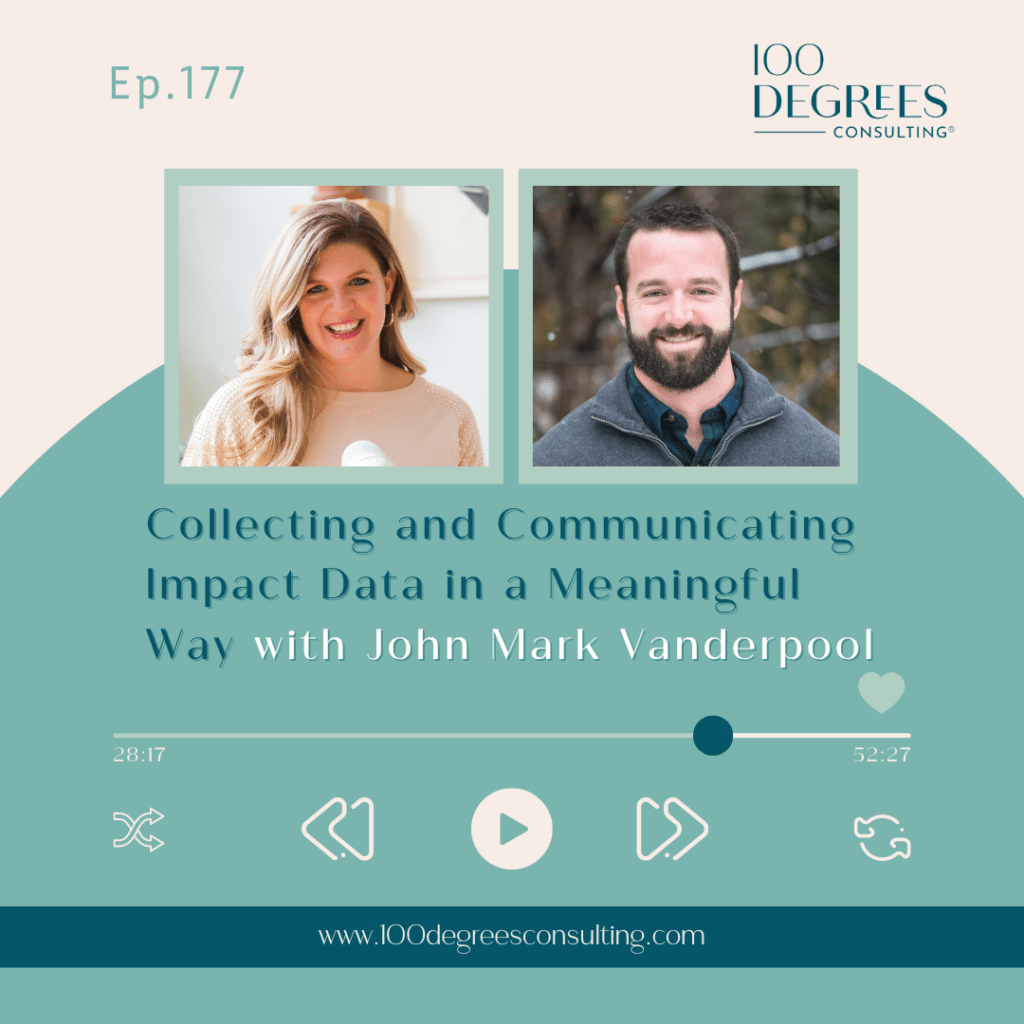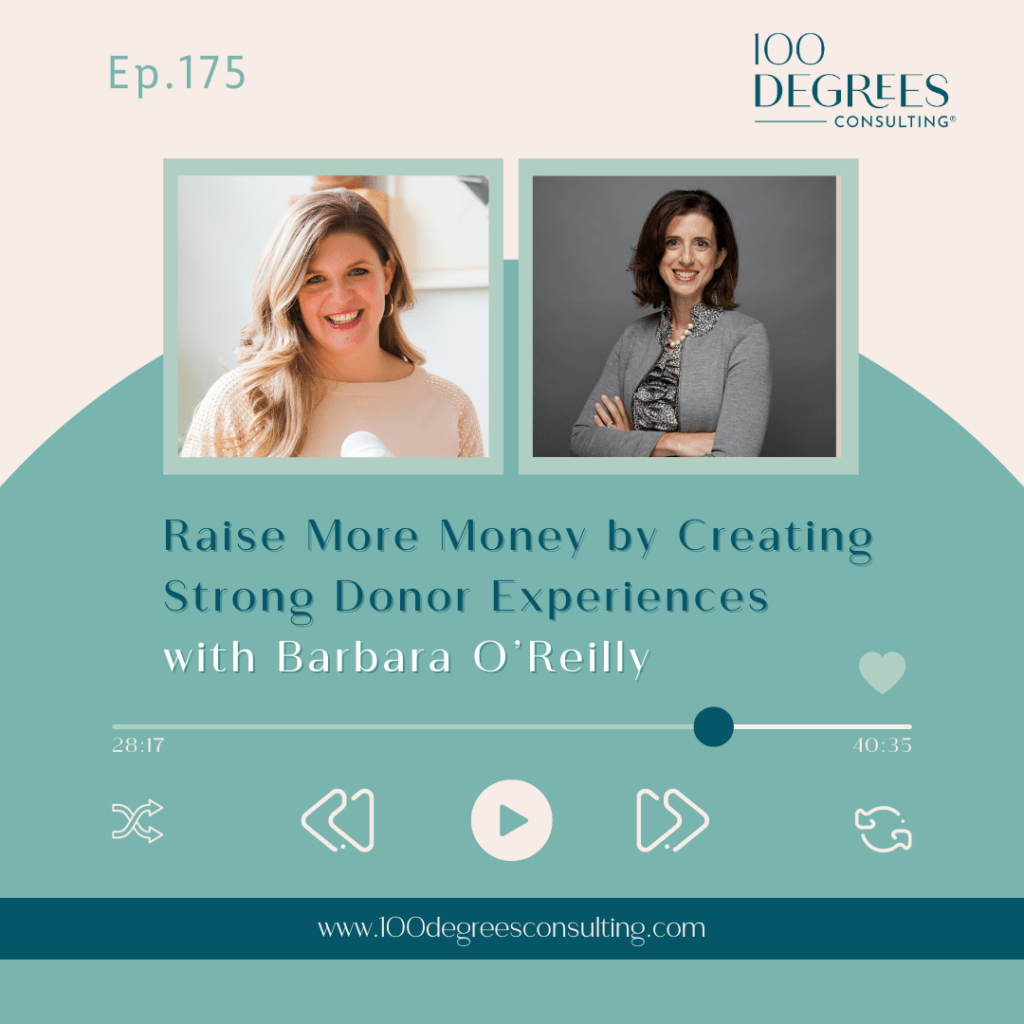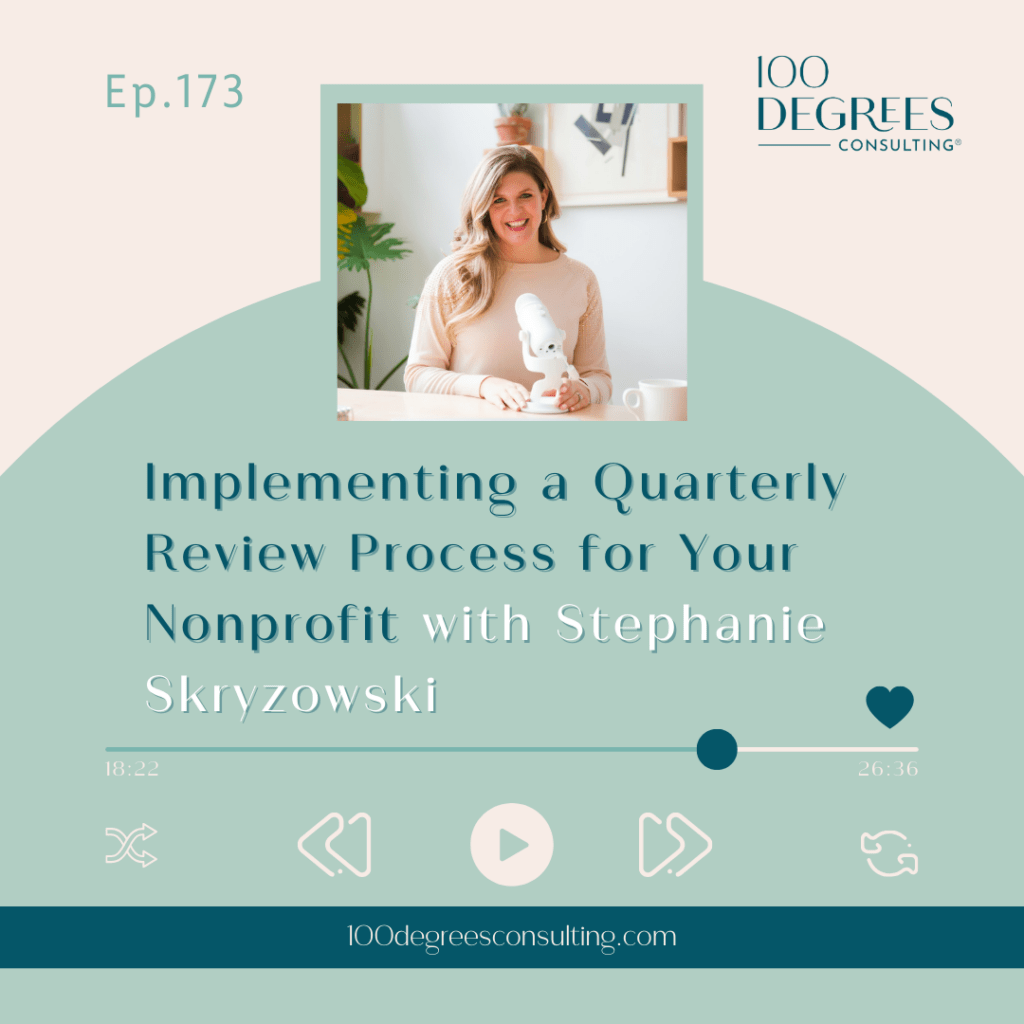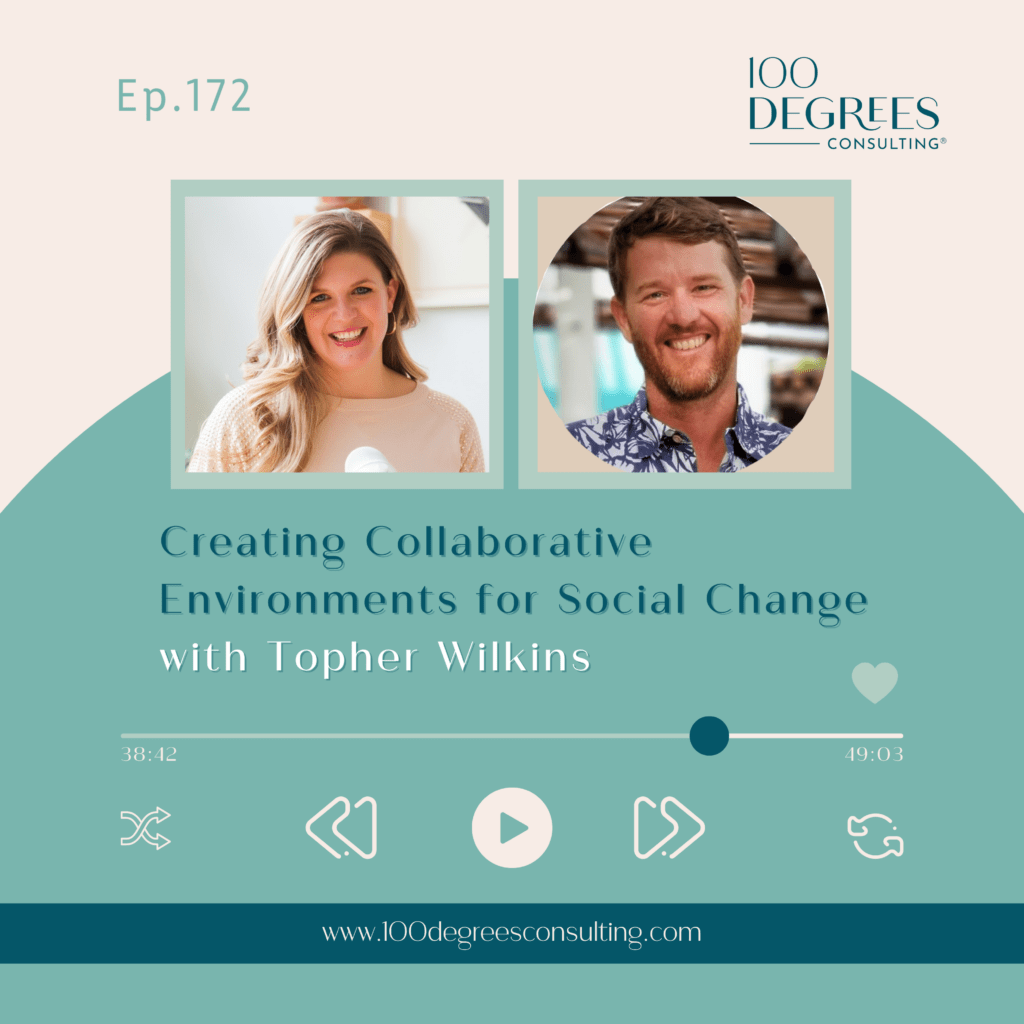Transcript Episode 139 – Building an Inclusive Culture with Yanira Castro on The Prosperous Nonprofit
Stephanie Skryzowski: [00:00:00] Welcome to the prosperous nonprofit, the podcast for leaders who are building financially sustainable and impactful nonprofits and changing the world. I’m Stephanie Skrzewski, a chief financial officer and founder and CEO of 100 degrees consulting. My personal mission is to empower leaders. To better understand their numbers, to grow their impact and their income.
On this show, we talk to people who are leading the nonprofit sector in new, innovative, disruptive, and entrepreneurial ways, creating organizations that fuel their lives, their hearts, and their communities. Let’s dive in.
Hey, welcome back to the show today I have on with me, Janita Castro, and she is the founder and CEO of Humanity Communications Collective, which is a luxury justice driven strategic communications agency focused on making human and [00:01:00] emotional connections. So Janita and I have known each other for a little while.
And today we talked all about how nonprofits can really ensure their communications are inclusive and non exclusionary. Thank you. We also talked about the freaking incredible culture that you need to has built in her company and how intentional she has been about creating an organization that is the place that she would want to work.
And so this is going to be lots of great takeaways for nonprofit leaders and for others who really want to build a workplace that you enjoy going to. So she’s fantastic and we had a great conversation. So let me give you. All of her like official background. So you can be fully impressed before we dive into the interview.
So Janita Castro is a speaker and communications professional with more than 20 years of experience in telling inspiring stories to audiences ranging from national television shows to leading digital channels. She founded humanity [00:02:00] communications collective in 2017 to inspire people with stories of joy and justice.
The team made up of amazingly talented women and people of color. Is highly focused on digital engagement and storytelling by reminding people to embrace technology, business and life. In a way that focuses on people’s humanity. Humanity Communications Collective has also shared important and groundbreaking client stories on CBS This Morning, ABC News, 60 Minutes, Essence, Now This, Oh, the Oprah Magazine, and many others.
Of humanity’s clients, past and present include the Marsha P. Johnson Institute, Outdoor Afro, the National Wildlife Federation, the Latinx House. Justice for Iger Oman, the Solutions Project and Davidson Wine Company. She has also built humanity to be an employer of choice. By understanding that toxic work culture is at the root of the great resignation she holds and practices core company values of [00:03:00] authenticity, respect, and justice.
Okay, so that is like a super impressive bio. So Janita has. All of the skills, all of the expertise, but also just this beautiful way of approaching organizational transformative culture. So we talked a lot about the core values of her business and to how she incorporates that into all the decisions that she makes.
And it’s really the lens in which she makes decisions. So. Anyway, I could go on and on, but we had a fantastic conversation and I’m super grateful to Janita for sharing her time with me today. So let’s get to it.
Hey everybody. Welcome back to the prosperous nonprofit. I’m really excited to be here today with Janita Castro of Humanity Communications Collective. Janita, welcome. Hi, Stephanie. Thanks
Yanira Castro: for having
Stephanie Skryzowski: me. Yes, I’m so glad to be here with you today and really excited to learn more [00:04:00] about your work and how you support nonprofits.
So let’s dive into first, why don’t you tell us a little bit about yourself and about your company, Humanity Communications Collective? Absolutely. Thank
Yanira Castro: you. Like you said, my name is Janina Castro. I’m the CEO at Humanity Communications Collective. I’m based in Charlotte, North Carolina, but I’m a New Yorker through and through.
So we are an agency that works with mostly nonprofits in order to help their communication strategy. So that means make sure they’re telling the right story at the right place at the right time. And we do that mostly through digital means. So we support on their story. They’re telling on their website, through their social, through their newsletter and through PR and media and through content creation.
We have a team of 15 people in three different countries. We’re fully remote and we are 99 percent women and 99 percent people of color that work at humanity communications. And it’s, uh, something I’m very, very proud of.
Stephanie Skryzowski: Yes, I definitely want to talk about [00:05:00] your company culture because I think you’ve built something really unique and really special.
So we’re going to get there, but I first want to ask, what did your path look like? How did, because Humanity Communications Collective was founded, like you’ve been around for six years. Is that right? Yeah.
Yanira Castro: 2017.
Stephanie Skryzowski: Okay. Okay. So. What were you doing before that? How did the business come about? So I’ve been in
Yanira Castro: communications my entire career.
I started at a boutique high tech PR firm in Manhattan in the early 2000s and have worked with a number of different corporate restaurants and their marketing and communications. Um, and then I was working actually in a brokerage house. Doing financial corporate communications, which is so boring for me.
It was so boring, but it was the job that I needed at the moment. It was close to my home. It paid really well. It allowed me to sit in social for a number of years to really understand how all that works. And I got to a [00:06:00] point where I was just the finance business is really boring for me and it’s so process oriented and I’m an activator right I like to move and make changes and make quick decisions.
And I was working with a nonprofit as my side hustle they needed help with their social media. And I love that the work that they did and the executive director was like hey, you’re really good at this communication saying like I’m about this is what I do for a living because he was watching what I was sharing.
Great. And all of that and she asked me to to work with them and I did that and I loved it so much that I was able to move quickly right and also understand I looked at their website I said listen I can’t support you on the social unless we fix your website because those two things are so integrated together and so we need to work that she said do what you have to do and she gave me full reign to kind of Just to level up all their communication.
They had done a great job, but it just needed it just needed some fresh eyes. And when I did that work, I was so invigorated and excited. [00:07:00] And I said, Oh, I should do this. This is definitely more fun. And then my grandmother passed away. And I went. To the funeral to help my mother with the arrangements, and I also thought I want to move with more flexibility in my life.
I want to do work. I really love and I want to be able to do it from anywhere I want. Um, and I will only want to do work that I’m really passionate about. And so that’s how I made the change.
Stephanie Skryzowski: I love that. I feel like my transition into my business from working inside a nonprofit as a CFO into my business was for very similar reasons.
I also happen to be like wanting to start a family at that time, but, but like you said, wanting to just be able to work on my terms and doing only the work that I really cared about versus all the other stuff that you have to do when you work for somebody else. So I love that story. Thanks for sharing that.
Yes. So. Storytelling is really at the heart of what you do. You’re [00:08:00] telling, helping organizations tell their story. And I feel like there’s a lot of talk in the nonprofit space of storytelling in a respectful way, that’s not this sort of like. Poverty porn in terms of like, you know, just sharing these sob stories for the sake of attention, but storytelling in a respectful way.
And so I’d love to hear you talk a little bit more about how nonprofits can communicate and making sure their communications are inclusive, are non exclusionary, and are not this, you know, sort of, um, I don’t know the right word to describe it, you probably do, but like, you know, just sort of showcasing these sob stories for the sake of attention versus storytelling in a respectful manner.
Yanira Castro: Many of us have been to one of those luncheons where you go in and the, you know, salad is in front of you and the, the nonprofit is telling about their business, right? And at some point during this hour luncheon, they bring up someone they helped or they have a [00:09:00] video. That shows tragedy and, and sorrow and it is moving and it’s emotional in a way, right?
It makes, it does make people open up their wallets, but we want to really look at the reason why they’re opening up their wallets. We understand that there is a need to ensure that we can showcase empathy, but also joy and solutions, right? And when you come from that center of how do we uplift people in a way that keeps their humanity at the center of themselves, that they’re not being choked out for a donation, that’s when you really start to dig in and understand.
There’s more power in telling a story that is centered in somebody’s lived experience in a way that showcases them as a hero of their own narrative and not the non profit being the hero, right? And that’s what a lot of those old school mentalities of those launchers are for. Look at this person we helped.
Without them, they would have [00:10:00] been still on the street or homeless or whatever it is. That doesn’t feel good for individuals. And so that’s the change that that we like to make that we like to see with nonprofits. It’s really changing the story from them being the hero to the person that’s closest to the problem.
Um, and experiencing that, that they’re actually the hero of their own story. Hmm.
Stephanie Skryzowski: I like that thinking about the person as the hero and not the nonprofit as a hero, not the nonprofit, really centering themselves as the solution. And you know, when we think about our businesses and something that I have learned as a business owner and really learning marketing, because I’m not a marketing person, I’ve only learned in order to help grow my company, but really is selling the transformation and selling the solution is something I’ve learned as a business owner, how to market ourselves versus like.
Selling the problem. Um, and so I like. That that’s essentially like what you’re doing with nonprofits as well. You’re talking about the [00:11:00] solution and the transformation and placing the, you know, the person or whoever was served as the center of that narrative. That’s interesting because I hadn’t really, again, I’m not a marketing person clearly, but I hadn’t thought about that in the nonprofit sector before in terms of like sort of selling that transformation or selling that solution.
But it sounds like that’s kind of what. What you’re talking about as well.
Yanira Castro: Absolutely.
Stephanie Skryzowski: Yeah. So you also talk a lot about making sure that nonprofits that their language and their communications are inclusive, non exclusionary. Talk to us more about what this really means and how you support organizations in this way.
Most
Yanira Castro: nonprofits, they’re not employing the folks that they are, they’re, they’re supporting or they’re helping. Right? And as we like to say, the people that are closest to the problem are closest to the solution. And so if you’re working in the field that we work in, which is justice related causes, climate, [00:12:00] environmental, gender, reproductive, racial, economic, workers rights, all those different types of justices, we say we love all the justices.
We want everybody to have justice. Um, A lot of the nonprofits that are serving those folks are filled with people that have never experienced any of those issues. They’re filled with folks that have really wonderful hearts, great hearts, but have never experienced what it’s like to live in a toxic environment, right?
They never grew up next to, let’s say, an oil refinery or having the health impacts of that. A lot of the folks are really privileged and they have, again, good hearts and want to help and they have great ideas. But we need to talk to the people that we’re serving, right? And so when I think about the folks at Humanity Communications, all of us are, are close to a lot of these problems that we’re having.
We’ve either experienced them, have experienced them, have families that experience them. [00:13:00] Um, and we’re able to think about how do we connect with those folks that are closest to the ground? Because a lot of us are the folks closest to the ground. And so, You know, what I always want nonprofits to do is, is when they’re looking at their own hiring systems is who are you bringing in to serve your community and, and really look at folks who are in that community to help you get to your goal.
Stephanie Skryzowski: I think you’re right in that. And I’m just thinking about different examples of nonprofits that I have worked in or with. And you’re right. Many times, the people that work for the organization are not the people with the lived experience of the people that or the situations that the organization is serving.
So it sounds like. Sounds like a lot of your work almost backs up to like, Okay, well, who do we have on the team internally? And it sounds like your team can sort of fill some of those gaps if organizations don’t have people [00:14:00] that really understand from a lived perspective, um, what The people who the organization is serving are experiencing.
Do you help organizations like sort of figure out, I mean, I know you’re obviously not like recruiting, but do you help them sort of figure out how to fill those gaps? And do they understand that they even have a gap? Like, do you come into situations where they don’t understand that there really even is a gap between who’s working for the organization and the people that they’re serving?
Yanira Castro: Yeah, usually it’s a yes and those things are happening. It depends on on the organization of where it is in its journey. Um, and then of course, you know, we’re not We’re not recruiting or hiring, but we can point out gaps. And I think that’s what’s important is going, hey, like, okay, I’m looking at your team and you’re talking about wanting to be more inclusive, um, in your communications, but your folks are only coming from one lens.
Which is why you need us, number one, [00:15:00] right, but also, you know, as we work with organizations we end up communication is so integrated as part of everything. We end up looking at what obviously their website, hey this the language here and then we look at maybe a job description and go, hey, this is not reflective of the type of company you want to be.
So, you may need, you have a gap here, you may want to look at that. Because I think your other question was about, you know, inclusive communications, right, and You know, the DEI space and, and that, that phrase and that buzzword has been regulated to an office somewhere in an organization, um, and not fully integrated within the company.
And when DEI is fully integrated into the company, you don’t need an office to do that, right? That sits on the side. And so allowing and sharing with nonprofits, hey, make sure you’re looking through Everything you put out there in the world, whether it’s recruiting materials, fun development materials, whatever it is through this lens of how do I bring more people into the fold, right?
As you know, we worked with, uh, with the [00:16:00] university and I shared with the communications team, just a small change to stop using filters on your photos. When you filter. People’s complexions when you use those filters, it changes the way somebody looks right and that even that was such a huge aha moment that they’re not thinking about because they’re all coming from a similar background, a similar experience, and they don’t understand when you change somebody’s complexion.
That really changes who you know how you’re representing how they feel represented. So small things like that that that are not, they’re not intentional. Nobody’s going to be intentionally harmful, but they just don’t have the experience to know what that would feel like if it happened to them. Mm hmm.
Stephanie Skryzowski: Wow. What a powerful example. First of all, and what a small shift that that organization can make like, just don’t use filters on your photos, and that is going to allow someone to feel so much more [00:17:00] seen. That’s super powerful. And what I’m hearing is like the work that you are doing, it’s so much more than communications.
I mean, you are helping to transform cultures of organizations. And is that what you set out to do? Or has that been like a part of the process as your own work and your company has evolved? Yeah. No,
Yanira Castro: I definitely didn’t set out to do that. I, when I started, I, I was like, you know, if I could, if I could just help a couple organizations, you know, do a little bit social media better, maybe that’ll change something.
Maybe I can drive some traffic and get awareness. And that’s really all I was looking to do, right? Be supportive to organizations that, that I really love. But when you really dig in and understand that the communications is. It’s really the heartbeat of an organization because if nobody knows who you are, you can’t, you can’t reach the people you want to serve.
And if nobody knows who you are, then you’re not going to get the funding [00:18:00] to continue your work. Right. So what has happened is that we’ve built such a partnership with these organizations and such a high level of trust. that they come and ask for different types of support. Hey, can you look at this pitch for us?
We’re going to go to, you know, we’re going to go pitch for funding to the foundation or, Hey, you know, you have really great people that work for you. What do you do? How do you get that message out there? How do you talk about the values that you hold? And so when you build a relationship that’s based on trust, And you have an open opportunity to have discussions and you’re talking to the organization and you really become part of their team.
They open up and they ask all different sorts of questions and we’re always happy to support in those ways because we want our clients to consider us part of their team. And when you’re part of somebody’s team, you’re not regulated to this. That’s one little set of
Stephanie Skryzowski: deliverables. Right. And when you’re part of somebody’s team and you’ve built that [00:19:00] trust, you’re, I would imagine that organizations would be more willing to have those difficult conversations, um, with, with you and with your team, because you have built that trust.
And I feel like those difficult conversations are where the change happens. So that’s really interesting. So if an organization is listening to you and they’re like, Oh my gosh, where are our blind spots? Where have we perhaps not been as inclusive or where have we been exclusionary when we haven’t really intended to, where do they begin?
Is there any sort of like. self assessment an organization can do, or is it most beneficial for them to pay and hire an expert like you or, you know, an organization like yours? Um, where, where can they begin to really assess, okay, how, how have we been to date?
Yanira Castro: So it’s really hard to Diagnose yourself from the inside, right?
[00:20:00] Uh, the blind spots are blind spots for a reason, for a reason. And so, you know, if an organization is trying to do this on a, on their own or on a small level, you know, I always recommend that they at least have somebody from the outside. Because again, you just, you just need a different perspective. You can’t keep doing the same thing, expect to go to a different place.But for organized I’m always asking, What is your goal? Don’t tell me what your communications goal is. What is your overall goal? What is your overall mission? And let us help you decide how to get there. Because the journey is going to be different. And we know all the different journey tracks to get there.
But organizations, so many folks are so used to, this is how we do things. But just to step back and go, okay, what is our goal and how do we get there and if they want to do it internally, it’s really asking yourself why again and again and again, right? There’s a theory called the five whys. Okay, so we want to, we want to help people, you know, we want to help more kids to read.
Why? Um, because everybody [00:21:00] deserves to have, you know, great education and, and the, the love of books, but why? But why? But why? And if they can at least start asking themselves if I why, it can get very ethereal and esoteric, like, you know, we want a better planet, but I would start there internally, but always bring, find somebody else, even if it’s not, You know, it doesn’t have to be us.
We’d love it for it to be us. But even if it’s somebody who you trust, that is, that maybe you partner with, that works at another organization that you work with, that works outside of your industry, right, and can come in and just show you some different ideas and, and ask you some different questions that, that you’re not used to asking yourself.
It’s just get some outside opinion. And it’s, you know, feedback can be tough, but we need to hear the tough things in order for us to really maintain, especially if we’re looking at changing people’s hearts and minds. Mm hmm.
Stephanie Skryzowski: Yeah, that’s so true. Your blind spots are your blind spots for a reason, because you like literally cannot see them, so you need somebody else.
And I think like, Yeah, it may be [00:22:00] a difficult conversation, but the change that you really want to see is only going to be on the other side of that difficult conversation. So I think organizations that are willing to do the work. Yeah, I think that is great advice.
Do you feel like you’re missing something when it comes to your nonprofit’s finances, but you have no clue what you might be missing? I’d venture to guess that one of the reasons you feel overwhelmed and nervous about your financials is because you don’t have a solid monthly routine. So I have created a free finance routine checklist for you.
The spreadsheet will help you know exactly what to focus on monthly, quarterly, and annually, so you never miss a beat. Staying on top of your numbers every single month will help you feel more confident as a leader. and grow your impact and your income. I’ve made the checklist for you. Now all you have to do is use it.
Gain more clarity into [00:23:00] your numbers, more cash in your bank account and more impact in your community. Head over to 100degreesconsulting. com slash routine to get the checklist.
So you’ve talked a lot about culture. Inside organizations, and I know that you have built an incredible culture with your 15 team members at Humanity Communications Collective. So I would love to hear, talk to me about the culture of your company. What makes your organization special and how did that come to be?
I mean. Yeah, tell us about your culture first and then I have like 50 follow up questions.
Yanira Castro: It’s my favorite conversation. We hold five values at Humanity. Their respect for people, that we’re just in minded, that folks are their true selves, we’re dedicated and results oriented. We delineate that into [00:24:00] be kind and be effing good.
And which is their favorite, which is their favorite value. As they talk about their favorite value and lifelong learning. Those are our five values. And so when we look at those five values, for me, they really. They really set the foundation of the culture. We look at hiring through those lens. We look at promoting through those lens.
We look at when we’re making tough decisions, we look through the value that our lens value to understand, okay, it’s just part of our lifelong learning. Um, when we’re having conflict resolution, are we having respect for others when we need to do this, when we’re looking at clients to work with. You know, are they are they do they hold the same values?
Are they also justice minded, right? Do they have respect for us in our work? And so, um, living through those values really builds a culture. Our true selves is one of their favorite ones, right? Because, of course, we want to show up in ways that are professional. But when we get on calls with some [00:25:00] of our clients, we’re talking about hairdos, we’re talking about, you know, the funny meme we just saw where we have a team member who brings the worst dad jokes.
To the opening of meetings, it comes in quirky and playful and everybody is comfortable and when people are comfortable in that way that they can show up who they are on a good day or a bad day, their creativity and their ideation is so much better than if they’re spending their energy making sure that they show up in a corporate way.
That’s better results for us and for our clients. And so it’s really fun to be able to hop on a call with a client and talk about some innocuous, you know, trending thing that happened, the Oscars, right. Um, anything like that. And it, it just makes us more comfortable. It makes them more comfortable to, to share, you know, things with us that feel really internal for the organization, but the more that we know, the better we’re able to help.
So those, those [00:26:00] values that we hold really build our culture in a way that people really enjoy. Working with us. Yeah.
Stephanie Skryzowski: Cause I mean, we are, this is like the stupidest obvious thing to say, but we are all people and we are all unique and to be able to just like be yourself in, in your work where we spend so much of our time and energy is so powerful.
And I love that you connected to that too. People’s creativity. And I know that when I feel like I’m placed in a box, I’m like thinking inside that box as well. Whereas when you are free to express yourself as you are, like your creativity will abound.
Yanira Castro: The other thing about culture that’s so important, and I think this is a lesson for anyone, especially nonprofits who are doing mission driven work, is understanding.
The barriers we’re putting into place I’m bringing people in right and so those barriers can be education, they can be geographic, they can be [00:27:00] experience but we really look at people’s lived experience and how they can connect to the work that we do. And that’s a very. different value than looking through, okay, did they get a bachelor’s in communications?
Have they worked in this field before? Have they worked with nonprofits before? And all those things are great. I need people to be great at what they do, but I really need people to be passionate more than anything. I can teach and train about just about anything, but what I can’t teach you is to really love the mission of the work.
And so, When we hire folks that are a culture fit and a mission fit and say their skills are, you know, a five out of 10, I, we get them to nine out of 10, we get them 10 out of 10, but we cannot change people’s passion. And so that’s an important part of building and building the culture.
Stephanie Skryzowski: And is there anything that you’ve done differently or like in a unique way?
Through your like recruiting process when you’re posting job applications and [00:28:00] screening candidates and interviewing them, is there anything that you do differently that helps you really find that culture fit versus checking a few boxes on their resume?
Yanira Castro: I think for us, it’s what we put out there in the world as an organization makes people want to work with us.
I will say the first time when I first started, Looking for some I was looking for someone to come in to do some contracting work for kind of website and newsletters and all of that stuff and I put in I didn’t do any kind of, you know, official job description or job posting and like that. But I went into some Facebook groups that was that I was in.
And one of the things I said was that if you can’t say Black Lives Matter do not apply. Mm hmm. Right. And what we put out there in the world about who we are and how we show up and what we believe in attracts the right people. So by the time they’re getting to us, they are, they understand who we are and our recruiting [00:29:00] process is pretty standard.
But I think what we put out there in the world does a lot of the filtering for us.
Stephanie Skryzowski: That’s a really good point at your work. And like you said, what you put out into the world, it speaks for itself. And so you’re not likely going to attract somebody. You’re not going to have candidates that already are not aligned with your values.
I love the fact that you talked about your values really being a lens for like everything that you do for hiring, for firing, I would imagine for even the clients that you work with. And we are, we’re the same way. So, Like we have KPIs based on our values. We have internal like team awards based on our values.
We’re thinking, you know, we ask, um, candidates throughout like the interview process, how they’ve exemplified certain, you know, of our core values in their previous work and in their lives and things. So I love that. Do you see that is common in the nonprofits that you [00:30:00] work with as well? Are they. Sort of like living and dying by their core values as well.
Did they have, I know, I’m just thinking about one organization that I’ve worked with, they definitely do have core values and they definitely did sort of. Live them in their everyday work. Do you is that common in organizations or not so much. I think for the
Yanira Castro: ones we work with it is they are mission driven organizations.
I do think they’re all on a different journey, especially, you know, we’re working with a lot of black and brown nonprofits and when we’re thinking about 2020 and the racial reckoning and all that happened there and the money that was Really funneled into a lot of, a lot of nonprofits that were justice centered is that they grew really fast or able to, they were able to put lots of people on the ground to support the communities that they serve and For some, they’re looking back now and they’re going, okay, we need to, we need to like restructure.
We hired all these people [00:31:00] to serve all these people because we were able to and we maybe pulled a little bit away from what our mission was in the beginning or our values are. So there are some in that, in that stage. And there are others that are are super intentional as we are to make sure that the people that are bringing in are a cultural fit as well as a technical fit for the organization.
And so I, I see both, but I see from the majority for are the ones we work with, they are really living, they are really living those values. And if they didn’t, we probably wouldn’t work with them.
Stephanie Skryzowski: Yeah, that’s a good point that that’s probably a lens that you are using to assess organizations if they don’t have strong values that they are really exemplifying then they’re probably not going to be a fit for you either.
Yeah, that makes sense.
Yanira Castro: Yeah, I think it’s so important for us to because, as I said earlier, like we really want. our partners to consider as part of their team, which means we’re working with many people throughout the organization. We can work with the ED, we can work with a community manager, we work with the program folks, we’re working with development, we’re working with comms [00:32:00] people, if they have them internally, we’re working with all of all of those people.
And so We really want to make sure that when we’re working through the organization that they are living the values and that we’re connected in that way, or it’s going to be really hard to work with them, right? If we’re talking, if we’re talking in the way we’re like, okay, do we have respect for the people that we’re serving?
Are you willing to learn more and do something different? Right? Are we showing up as our true selves? Are we being kind to our community that we’re serving? Are we being good to them? Right? And if internally that’s not happening, then it’s going to be friction because we’re going to go, hey, that’s. That’s not how we talk to people, not just here, but anywhere, right?
That’s not how you talk to people in need, or that’s not how you talk to people that are in support. And that’s not going to feel good for us. Did you
Stephanie Skryzowski: ever have, and I’m sort of asking for my own, like, I’m interested because I have an experience related to this, but, you know, as you. In 2017 built this company and had the power [00:33:00] and ownership to create an organization that you really wanted to and enjoyed working for.
Was that the result of any like toxic workplaces that you had worked at before? Um, and like then wanting to basically do the opposite. Oh my
Yanira Castro: God. Abso absolutely. I know. I say I . I’m the, I’m the boss. I always wanted for myself, right? Yes. . And I always say, I said I’ve, I learned so much on how I never wanted to be from bosses and managers that I have, but I learned the most from them.
Right. Um, the micromanaging the. Inability to have a real conversation with somebody, the inability to, to cry. I’m very emotional. I, my team will tell you, like, whenever I’m excited or I cry, like in every meeting, because I’m just so proud, right? But just stuff, all those feelings down in a way, you know, when we had a, a young team member started and, and she slacked me and she said, I got to go to the dentist, [00:34:00] but I’m only going to be gone 45 minutes and I’ll have my phone.
And it was like, Go to the dentist. What are you doing? Seeing your wisdom teeth out? Take the day or two and take care of yourself. Yes. And so that all that, you know, I call it corporate PTSD. Other people call it workplace injury. And all of that. So much of that, right? And when I’m like, no, it’s okay.
You’re, you know, your dog used to go to the fed. You need a nap. You’re tired because your baby kept you off all night. Take the nap at two o’clock. I don’t really care. I need you to. Exactly.
Stephanie Skryzowski: Yes. And also you don’t have to tell me if you’re going to the dentist, like go to the dentist. I don’t care. All
Yanira Castro: right.
Like you’re a full adult that I’ve given lots of responsibilities to. I think I’m going to be okay if you go to the dentist. But, you know, we laugh about it because to me now it’s so foreign, but most people coming to us are coming [00:35:00] from that experience in that background. And it takes a lot for them to ask for help.
Right. To say I’m going to miss this deadline. All of these things. So we have to create environment. I’m sure you do that. It’s okay that we’re here to support each other and especially when you’re all remote you have to talk about that even more because you can’t see it on people’s faces every day.
Stephanie Skryzowski: That’s so true. That’s so true. Cause in an office environment, you could see when people are like dragging and when things are hard, you can see it, even if they’re trying to like put on the, you know, happy face and you can see that, but remote, you really can’t. And it’s so, yeah, that’s so funny. That’s so true.
I used to remember just like feeling sick to my stomach, having to ask permission. To go on vacation or ask permission for a doctor’s appointment and just like feeling ill about it for weeks in advance. And I’m like, I never want to create that environment. And it’s just so funny. I’m like, I don’t care if you have [00:36:00] to go to the doctor, I don’t even need to know, just go take care of yourself.
We’re good. That’s so funny because I also feel like I am creating what I never had before. And so I just want to encourage any nonprofit leaders or leaders of businesses, listening, like, are you creating a culture that you would want to work in? Like, are you the leader? Are you the boss that you would want to have?
And maybe in many cases, yes. But if you really think about that, maybe not so much in certain ways. And so I’ve even had to examine this. In myself in the way that not when it comes to like doctor’s appointments and self care, but more in like the direction that I give to my team and I’m realizing that I have things in my head that don’t ever make it out of my mouth.
And so my. You know, direction is not as clear, or my expectations are not as clear as I have them in my head. And so that has led to [00:37:00] frustration on my team. Like, well, okay, I thought this was a priority, but actually you never really gave me a deadline. So I don’t actually know when I should be working on this.
And so I’ve had to be like, okay, am I borrowing from Brene Brown? Am I painting done? And a lot of times I have not been great at that. So I feel like there’s. Always growth. I’m
Yanira Castro: so with you, right? Yeah, I love Renee Brown and like what has done look like, right? What does that look like? And I think it’s the expectation.
I really believe that in any business, especially nonprofit, people want to know, you know, what our larger goal is. Right. What is our larger goal? But then how, what do I do to help that larger goal? So what are my expectations? Like, how do you want me to show up? How do I deliver things to you? How do you want me to accept and receive feedback and give feedback?
But expectations to me has been the biggest thing that has also stuck in my head, right? Because I’m like, well, this is the way that. People should just do things and I don’t know why we think that they should just know how to do things. I’ve been doing this, you know, this [00:38:00] work over 20, almost 25 years and I have 25 year olds on my team.
Clearly different level of experience, right? So I have to set expectations on what I want things to look like. And yeah, and I, I think in nonprofits, especially when you’re doing program work, right? We, we just got to feed the people. We just got to. Get the folks in the door. We just have to do this right and, and you’re so driven towards the larger goal of hopefully one day putting yourself out of business, which I think all nonprofits should want to do at some point.
Yep. Forget that we have to outline some of the steps to get there. Because mission is great, but it’s not enough for folks to you. They need to feel part of it and understand how they are part of this larger goal and mission that they have.
Stephanie Skryzowski: Mm hmm. Yeah. Yeah, absolutely. I love that advice. Well, as we start to wrap up, um, one question that I ask all of our guests is what does a prosperous [00:39:00] nonprofit look like to you?
Yanira Castro: For me, a prosperous nonprofit looks like that they understand who they are and where they want to go. First and foremost, I know, of course, I’m looking through a communications lens, right? But they have to know what story they want to tell. But they also have to have really strong communications, because again, if they are Right.
Looking for awareness or if they’re looking for to raise money or they’re looking to support people on the ground and whatever field that they’re in, people need to know who they are and that they’re available for them. So in order for them to do that, they have to have strong communications. And I really believe they have to have strong finances and operating budget to support not only the people on the ground, but also to support their team members, right?
Um, non profits, we really, really need to pay their team members well. They’re typically, they are working for the mission of the organization, right? [00:40:00] We talk a lot in the world about self care and about balance and all of these things and nonprofits. I think right now are some of the biggest perpetrators of just working people 15 hours a day, right?
And yes, they do in the work because they love the mission, but you have to pay them well or they’re going to burn down. They’re not going to be any helpful to you. So prosperous means looks like the communication of good standing of where you’re going and having strong financials.
Stephanie Skryzowski: I love that. I love all of the pieces of that.
Yes. Nonprofit leader burnout is something that I’ve been thinking about. I’ve been having a lot of conversations around because I feel like the messages and the culture of self care in like not in the spa massage. Way, but like in thinking about like, are we working in our zone of genius? Are we delegating?
Are we managing our time appropriately? Do we have enough like infrastructure inside the organization so that, you know, we [00:41:00] are efficient in the way that we’re working in that, like that conversation of self care. I feel like it’s just not, I’m having lots of conversations with nonprofit leaders who are doing this really well, because that’s not common.
And so I love that you talked about. A prosperous nonprofit, really having people working inside of it that are well taken care of in all aspects, because at the end of the day, if the people are not taking care of, and if they’re failing, then the organization is going to fail. So that’s so important.
Beautiful. Well, Janita, thank you. So much for chatting with me today. This was an amazing conversation where if our listeners want to find out more about you and about humanity, where can they learn more? Thanks,
Yanira Castro: Stephanie. Um, three places you can go to our website, it’s humanity cmm.cm. You can go to our Instagram, which is humanity, C O M M.
And you can find me on LinkedIn, Janina Castro. [00:42:00] I’m pretty active on there. I love to connect with people in, in those two places.
Stephanie Skryzowski: Amazing. Awesome. Well, absolutely go check that out. And I was telling Tanita before we started recording that I love on her website, humanitycom. com slash donate. You can not only learn more about her company and the work that they do, but also the amazing nonprofits that they serve.
She’s got them just beautifully highlighted on that page, and I absolutely love that. So thank you again for being here. I so appreciate
Yanira Castro: you. Thank you, Stephanie. So great talking to you. I’ll see you soon.
Stephanie Skryzowski: Before you go, I just want to thank you for being here. To access our show notes and bonus content, visit 100degreespodcast.
com. That’s 100degreespodcast. com. And I’ll see you next time.



